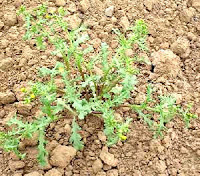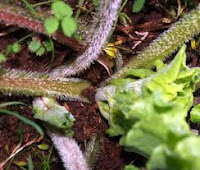EARTH NUTS, PIGNUTS, CONOPODIUM MAJUS
Pignuts are so named because pigs love to find these, as do European Brown bears. They grow in woodland in Europe and in Britain
In the UK
They were clearly known in Shakespeare’s day as he has his ‘monster’ Caliban tells Trinculo (a drunken servant) that he will show him the delights of the island which include these ‘nuts’.
“Caliban: I prithee, let me bring thee where crabs grow,
And I with my long nails will dig thee pignuts.”
(Act II scene ii The Tempest)
 John Gerard, writing in the 16th century tells us that there was a “Plaister made of the seeds” of the plant, but he rather coyly declines to continue as regards the use it was put to. This mystery was later (probably) solved when Nicholas Culpeper writing in his Complete herbal in the 17th century points out that the nuts were aphrodisiacs and stimulated “venery” or lust. He calls these “Earth chesnuts” and says this: -
John Gerard, writing in the 16th century tells us that there was a “Plaister made of the seeds” of the plant, but he rather coyly declines to continue as regards the use it was put to. This mystery was later (probably) solved when Nicholas Culpeper writing in his Complete herbal in the 17th century points out that the nuts were aphrodisiacs and stimulated “venery” or lust. He calls these “Earth chesnuts” and says this: -“They are called earth-nuts, earth-chesnuts, ground-nuts, ciper-nuts, and in Sussex
Government and virtues. They are something hot and dry in quality, under the dominion of Venus; they provoke lust exceedingly, and stir up to those sports she is mistress of; the seed is excellent good to provoke urine; and so also is the root, but it doth not perform it so forcibly as the seed both. The root being dried and beaten into powder, and the powder made into an electuary is as singular a remedy for spitting and pissing of blood, as the former chesnut was for coughs.”
“Peritonitis is treated by means of an emetic, the blue confection and a medicine. These are the herbs required (for the medicine ;) the sweet gale, bay leaves, pimpernel, male speedwell, river startip, borage, moss, liverwort, the young leaves of the earth nut, and the mallow.”
They also used it in treatments for intermittent fevers as this remedy shows:-
 ”The following is a good medicine for this class of diseases : take moss, ground ivy, or elder, if obtainable, (if not obtainable, caraway,) and boil these two vegetable substances well together. Then take the mallow, fennel, pimpernel, butcher's broom, borage, and the young leaves of the earth nut, and bruise them as well as possible, putting them on the fire with the two herbs before mentioned, and boiling them well. This being done, let elder bark be taken from that portion of the tree which is in the ground,-let it be scraped and washed thoroughly, and bruised well in a mortar. Then take the liquor prepared from the fore-mentioned herbs, and mix the said bark therein assiduously between both hands, and set it to drain into a vessel to acidify, fermenting it with goat's whey, or cow's whey. Let a good cupful thereof be drank every morning as long as it lasts, a portion of raw honey, apple or wood sorrel, being taken subsequently in order to remove the taste from the mouth, after the draught. This liquor is beneficial to every man who requires to purge his body.”
”The following is a good medicine for this class of diseases : take moss, ground ivy, or elder, if obtainable, (if not obtainable, caraway,) and boil these two vegetable substances well together. Then take the mallow, fennel, pimpernel, butcher's broom, borage, and the young leaves of the earth nut, and bruise them as well as possible, putting them on the fire with the two herbs before mentioned, and boiling them well. This being done, let elder bark be taken from that portion of the tree which is in the ground,-let it be scraped and washed thoroughly, and bruised well in a mortar. Then take the liquor prepared from the fore-mentioned herbs, and mix the said bark therein assiduously between both hands, and set it to drain into a vessel to acidify, fermenting it with goat's whey, or cow's whey. Let a good cupful thereof be drank every morning as long as it lasts, a portion of raw honey, apple or wood sorrel, being taken subsequently in order to remove the taste from the mouth, after the draught. This liquor is beneficial to every man who requires to purge his body.” They don’t mention the aphrodisiac qualities but it makes sense that Shakespeare’s Caliban would have enjoyed them if they had such a reputation as he was a portrayal of the baser side of human nature.
















































